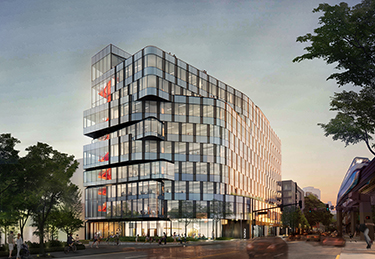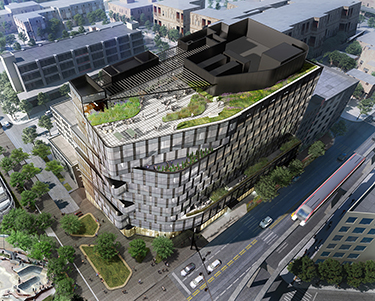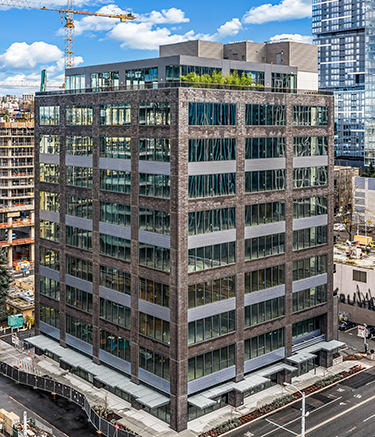|
Subscribe / Renew |
|
|
Contact Us |
|
| ► Subscribe to our Free Weekly Newsletter | |
| home | Welcome, sign in or click here to subscribe. | login |
Architecture & Engineering
| |
December 1, 2021
Re-inventing the lab
A/E Editor
Life science buildings are big business in Washington. According to the Puget Sound Business Journal, nearly 1.1 million square feet of life science projects are currently under construction with another 1.5 million-plus square feet planned. These projects take many forms and include new construction, project conversions and tenant improvements of existing life science buildings. They are also being built using a number of materials; steel, concrete and even mass timber.
“We are seeing a whole lot of life science projects, some from the ground up, others pivoting in the middle of design,” Roger Heeringa, principal at DCI Engineers, confirmed.
Architects are taking the opportunity afforded by this strong and growing market to push the boundaries of what a life science building/lab should and can look like and the life science market is quickly becoming a space for architectural, as well as medical, innovation.
“We want to discover the undiscovered of life science and lab buildings” Chad Yoshinobu, principal and global sciences practice area leader with Gensler Seattle, said.
Innovation aside, when designing and working on a life science project there are certain technical needs and demands that have to be met. The main consideration from a structural standpoint is limiting vibrations because of the sensitivity of lab equipment and the need to maintain consistent readings. Acoustic and vibration consultants generally recommend 4,000 to 8,000 micro inches per second (MIPS) for life science spaces whereas a typical office building has MIPS of 12,000. Roof loads should also be increased for life science projects because of a need for larger mechanical systems and equipment. Further, these spaces typically desire floor-to-floor heights that are 12 to 15 feet per floor to make space for robust mechanical systems.
These considerations were central to DCI Engineers' recent Boren Office Lofts Project which saw the conversion of a Class A office building, at 930 Boren Ave., into a life sciences building. To meet the needs of life science users, DCI retrofitted existing steel framing to support an increased live load to 100-lbs/sf, non-reducible; upgraded the column load capacity to support increased live load; maintained 12-foot clear heights below the structural framing and meeting the needs of upgraded mechanical systems; modified elevator shafts to support an additional entry to the freight elevator and modified the rooftop and floor framing to support additional air handling units, a backup generator, and other mechanical and electrical needs of the end users. Heeringa confirmed that Boren Office Lofts now has a life science tenant and final tenant improvements are currently underway.
When it comes to design vision, speaking with architects and looking at current and planned life science projects in Seattle and beyond there is more scope than one might think. Life science projects are about much more than providing lab space and a place to do experiments.
“At Gensler, what drives our life science projects is the goal of providing a space that allows for and encourages innovation. It's about much more than just creating a container for people, we want to create a space for our clients that will give them a leg up in this hot market and intense field,” Yoshinobu said.
In their projects, Gensler is taking successful elements from other markets and applying them to the life science space.
“A lot of our designs for life science are an aggregate from other markets such as the tech and hospitality industries,” Yoshinobu explained.
From the tech market comes the importance of providing flex work spaces and moving away from the sit at your desk model. The idea of creating spaces that promote relaxed attention is key and is especially important for life science clients whose ability to generate novel and transformative ideas is central to their work.
“For life science clients, I think the number one concern is having the ability to access outside spaces. In particular we are utilizing rooftops as an extension of the office with office spaces and rooms, places to meet and places to cook all incorporated,” Yoshinobu said.
Incorporating brand storytelling has also become a central idea in the design of life science projects - something that is also important in hospitality.
“It's essential that workers feel pride in the company and the job they are doing,” Yoshinobu said.
A Gensler life science project that incorporates these elements is 222 5th Ave N which Gensler has designed for developers Da Li Development USA. 222 5th Ave N is a commercial office building consisting of eight floors of office space over a ground-floor lobby. The 195,000-square-foot building has been designed to flex between an office or a laboratory space. A notable design feature is an interconnecting stair to one side of the building that links all eight floors and leads to a shared rooftop. According to Gensler's website, “This vertical ribbon of circulation will act as a catalyst for the community, untethering tenants from their floors.” The project also includes multiple roof decks “that offer year-round open and sheltered outdoor accessibility to fresh air and nature,” The expansive rooftop design consists of open-air gathering spaces, a rooftop garden and private areas set apart by green walls. These outdoor spaces are viewed as an extension to employees' indoor workspaces and a key area for promoting relaxed attention. The project is expected to break ground in early 2022.
Mass timber is another area where architects are pushing the boundaries when it comes to life science projects. No mass timber life science buildings currently exist in Seattle. However, this is unlikely to remain the case. Gensler, as part of the work of the Gensler Research Institute, is conducting a study with structural engineers at KPFF and mechanical, engineering and plumbing engineers with Buro Happold, on the viability of building life science projects using mass timber. The study takes the form of a hypothetical project and is due to be released this month. Yoshinobu says that all the data is pointing to the superiority of using mass timber in terms of aesthetic, environmental and structural benefits. Heeringa also said that DCI Engineers has a mass timber life science project on its books.
Emma Hinchliffe can be
reached by email or by phone
at (206) 622-8272.





